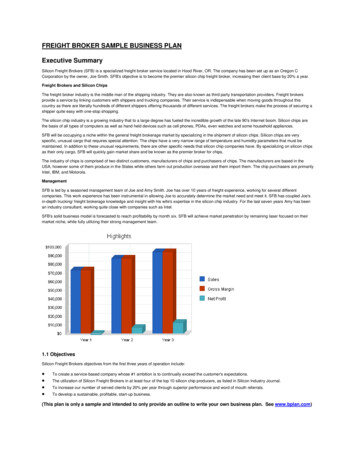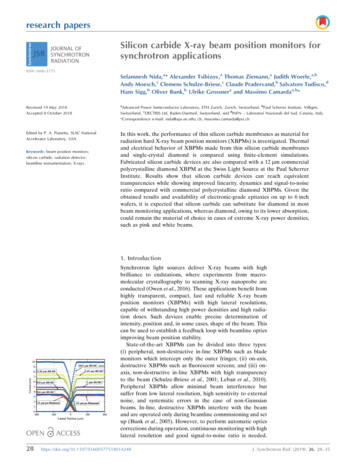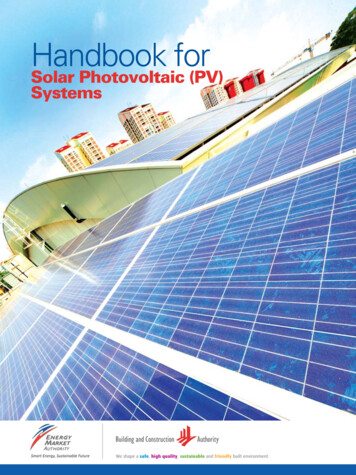Transcription
Nanophotonic silicon-basedbiosensors and biochipsIvo RendinaInstitute of Applied Sciences and Intelligent Systems “E. Caianiello”National Research CouncilNaples, ItalyI. Rendina, NanoInnovation, 16 Sept. 2020
One of the new frontiers of the“information age”, based on silicontechnology, is the realization ofphotonics devices integrated on chipcapable of manipulating light at thenanoscaleI. Rendina, NanoInnovation, 16 Sept. 2020
and also the realization of new chips capableof performing complex functions:– to sense and interact with the environment– manipulate fluids– to be remotely interrogated and poweredI. Rendina, NanoInnovation, 16 Sept. 2020
Health: a global challenge 1 billion, or half of the world’schildren, live in poverty more than half the deaths inthe poorest countries are theresultofinfectiondiseases(compared to 5% in the reachestones)[Source: P. Yager, et al., Nature, Vol. 442, 27 July 2006)]I. Rendina, NanoInnovation, 16 Sept. 2020
I. Rendina, NanoInnovation, 16 Sept. 2020
Challenges in biomedicine New technologies for small, cheap, reliable point-of-caretesting (label free nanosensor arrays and lab-on-chips) forinstant diagnostic, in any place at any time Very high sensitive biosensors, with extremely low detectionlimits for early stage disease detection Ultra-high resolution microscopy (below the diffraction limit)for real time sub-cellular imaging Microandnano-systems(i.e., in cancer therapy)forsmartdrugdeliveryI. Rendina, NanoInnovation, 16 Sept. 2020
Negativephotoniccrystalsto trap light at the nanoscaleand excite optical resonances useful in biosensingI. Rendina, NanoInnovation, 16 Sept. 2020
Well known applications ofplasmonic resonances in biosensingSurface plasmon resonance (SPR)sensorsSurface enhanced raman spectroscopybased on localized-SPR effectNature Reviews Drug Discovery 1, 515-528 (2002)Advanced Materials 18, 491 (2006) label free technique real-time detection high enhancement factorsI. Rendina, NanoInnovation, 16 Sept. 2020
Analogy between .metal plasmonic structuresMetals: Drude model. non-metal negativephotonic crystalsNon-metals: Lorentz model f 02 ( 02 - 2 j )I. Rendina, NanoInnovation, 16 Sept. 2020
Our idea: to exite plasmon-like resonancesat the interface with negative dielectricphotonic crystals, so avoiding:- optical absorption in metals- resonance peak broadening- local unwanted heatingI. Rendina, NanoInnovation, 16 Sept. 2020
Finite Difference Time Domainsimulations in a 2D negative PhCDevice realization2D PhC silicon slab on a SOI wafer Lattice constant a: 472 nm Hole radius r: 0.385a Thickness: 700 nm Effective negative refractive indexaround normalized frequency a/l 0.31I. Rendina, NanoInnovation, 16 Sept. 2020
Plasmon-like surface states:experimental characterizationI. Rendina, NanoInnovation, 16 Sept. 2020
Experimental evidence ofplasmon-like resonancesI. Rendina, NanoInnovation, 16 Sept. 2020
Sharp distributed resonances by excitingBound States in Continuum (BICs) of radiation modes Normal-to-the-surface configurationDistributed resonancesEasy and reliable coupling of light to PhCHigh enhancement of the E-field at the PhCinterfaceHigh-Q resonatorsGood tolerance to fabrication imperfectionsDistributed resonances with predicted infinite lifetimesFabrication imperfections and the finite extent of the structure partially break thecrystal symmetry allowing the coupling of these resonances, and the excitation ofevanescent surface wavesI. Rendina, NanoInnovation, 16 Sept. 2020
Qubit manipulation byoptical Quantum Spin-Hall EffectDesign and realization of new sensors:nanostructured surfaces where light isconfined and enhanced, enabling veryhigh sensitivitiesI. Rendina, NanoInnovation, 16 Sept. 2020
PhC sensing surface design- 2D-PhC in Si3N4 (n 2; h 60 nm)on a SiO2 substrate- square lattice of cylindrical holesa 500 nm; d 130 nm1) λres 780 nm2) λres 545 nm Ex 2 Ey 2E 108 Ei Ez 2I. Rendina, NanoInnovation, 16 Sept. 2020
Device fabricationI. Rendina, NanoInnovation, 16 Sept. 2020
Device characterization l 0.4nmQ 2x103 i 5 i 0 i -5 I. Rendina, NanoInnovation, 16 Sept. 2020
First study of MDM2-p53 protein-protein interactionI. Rendina, NanoInnovation, 16 Sept. 2020
BIC-Enhanced Fluorescenceλ 532 nmt 100 msPin 100µWRodamine 6G dispersed in PMMAC 10 µMSEF factor 103I. Rendina, NanoInnovation, 16 Sept. 2020
BIC-Enhanced Raman effect λ 532 nm Crystal Violet solution in ethanolFBIC-R 103I. Rendina, NanoInnovation, 16 Sept. 2020
BIC-LSPR hybrid effectAu-NPs diameter 40 nmlres 530 nmRandomly dispersedAu-NanoparticlesCrystal Violet moleculesFBIC-LSPR 13highlowI. Rendina, NanoInnovation, 16 Sept. 2020
Next step:integration with microfluidicsI. Rendina, NanoInnovation, 16 Sept. 2020
Nanosensor array200 µmPost-Oxidation1.0l 627 nmBragg 1Bragg 2Bragg 3Bragg 4Bragg 5Bragg 6Reflectivity (a. u.)0.80.6FWHM 25 00Wavelength (nm)I. Rendina, NanoInnovation, 16 Sept. 2020
Integration with microfluidicsAlignmentsetupI. Rendina, NanoInnovation, 16 Sept. 2020
Label-free DNA chip based on a microarray of nanophotonicbiosensors integrated with microfluidicsWhite lightsourceOSA No labeled samples Direct optical read-out Small liquid volume2I. Rendina, NanoInnovation, 16 Sept. 2020
Microfluidic chipsfor cancer cell detection:pA2036NHA20 lymphoma cell capture ona silicon substrateBS3NH2 NH2NH tOHSiSiO O O O OOHOHOHSilanizationSiSiO O O O OCrosslinkingSiO O OBioconjugationImmobilization scheme of A2036 peptide on silicon surface to detect A20 B lymphoma cells(APTES 5% in absolute ethanol; BS3 10mM; pA2036 150μM)I. Rendina, NanoInnovation, 16 Sept. 2020
aA20 cell detection on planar silicon pA2036modified-sensor after incubation with 1 104cells/mL (a) and 5 106 cells/mL (b).(c) Optical image of random-peptide modifiedsensor incubated with A20 cells. (d) Opticalimage of pA2036 modified-sensor incubatedwith 5T33MM cells.bAFM images of live A20 cells detectedon silicon surfaceCoverage of 85% of silicon surfaceI. Rendina, NanoInnovation, 16 Sept. 2020
beforewashgreen filterred filterafter washFluorescence image of A20 cells (green) detection in system mixed with 5T33MM cells (red)on planar silicon pA2036 modified-chip after incubation at indicated ratiosI. Rendina, NanoInnovation, 16 Sept. 2020
3D tracking of live cellsI. Rendina, NanoInnovation, 16 Sept. 2020
A whole flow-cytometerin a microfluidic chipI. Rendina, NanoInnovation, 16 Sept. 2020
Hydrodynamic focusing of cancer cellson a silicon chipI. Rendina, NanoInnovation, 16 Sept. 2020
Cell manipulation (rotation)for better on-chip imagingI. Rendina, NanoInnovation, 16 Sept. 2020
The research group in NapoliI. Rendina, NanoInnovation, 16 Sept. 2020
AcknowledgementsAnnalisa LambertiVito MocellaAnna ChiaraDe LucaStefano CabriniGiuseppe ScalaLuca De StefanoMario IodiceGiuseppe CoppolaI. Rendina, NanoInnovation, 16 Sept. 2020
(i.e., in cancer therapy) . Negative photonic crystals to trap light at the nanoscale . Fluorescence image of A20 cells (green) detection in system mixed with 5T33MM cells (red) on planar silicon pA2036







